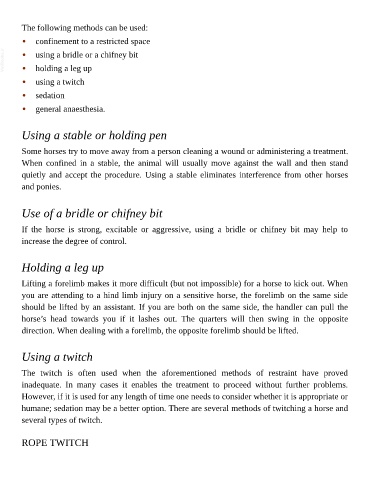Page 1081 - The Veterinary Care of the Horse
P. 1081
The following methods can be used:
• confinement to a restricted space
VetBooks.ir • using a bridle or a chifney bit
•
holding a leg up
• using a twitch
• sedation
• general anaesthesia.
Using a stable or holding pen
Some horses try to move away from a person cleaning a wound or administering a treatment.
When confined in a stable, the animal will usually move against the wall and then stand
quietly and accept the procedure. Using a stable eliminates interference from other horses
and ponies.
Use of a bridle or chifney bit
If the horse is strong, excitable or aggressive, using a bridle or chifney bit may help to
increase the degree of control.
Holding a leg up
Lifting a forelimb makes it more difficult (but not impossible) for a horse to kick out. When
you are attending to a hind limb injury on a sensitive horse, the forelimb on the same side
should be lifted by an assistant. If you are both on the same side, the handler can pull the
horse’s head towards you if it lashes out. The quarters will then swing in the opposite
direction. When dealing with a forelimb, the opposite forelimb should be lifted.
Using a twitch
The twitch is often used when the aforementioned methods of restraint have proved
inadequate. In many cases it enables the treatment to proceed without further problems.
However, if it is used for any length of time one needs to consider whether it is appropriate or
humane; sedation may be a better option. There are several methods of twitching a horse and
several types of twitch.
ROPE TWITCH

